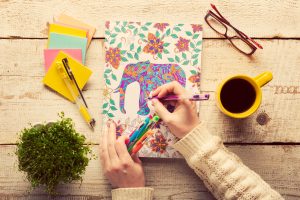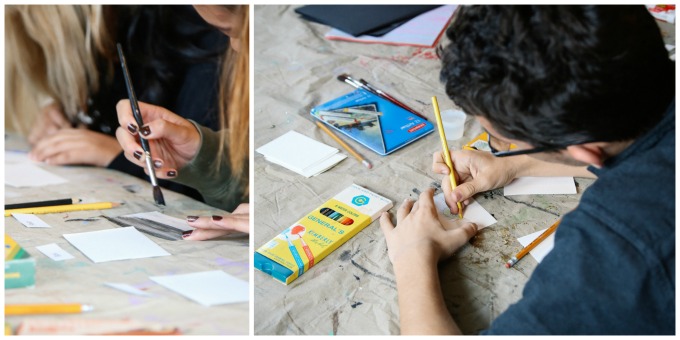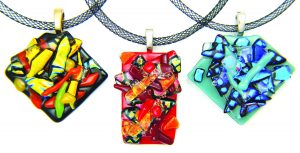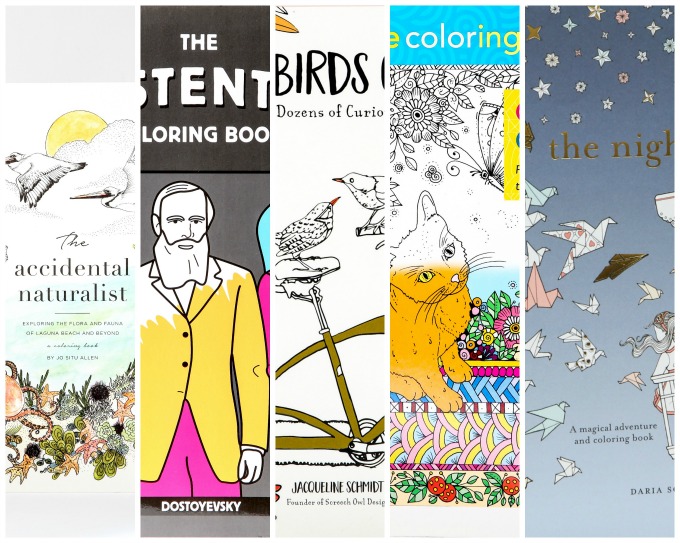
Creative endeavors help alleviate stress while providing a path for emotional healing.
By Sharon Stello
Each week at the local youth shelter—a temporary home in Laguna Beach for children who are struggling with traumatic life events—teens and preteens work through a jumble of emotions and find some solace as they shape clay into various figures, draw, paint or make prints in a program offered by volunteers with Laguna Outreach for Community Arts (LOCA).
Meanwhile, at the Laguna Beach Community & Susi Q Center, a new six-week class called Healing Grief Through Art will be offered this winter, allowing those who have lost a loved one to navigate the grieving process through creative outlets.
And, in a growing trend both locally and across the nation, adults are picking up coloring books—returning to this childhood pastime to relieve stress and anxiety. Plus, in this art-focused town, a broad spectrum of classes in mediums from painting to ceramics offer opportunities to relax, explore various emotions and heal with each meditative brushstroke or turn of the pottery wheel.
In fact, art as a form of therapy, either in a guided setting with analysis by a trained psychologist or as a coping mechanism employed by individuals at home, is gaining traction for its many benefits. Last year, a Drexel University study found that a person’s stress-related hormone levels drop significantly after just 45 minutes spent making art. Becoming immersed in an artistic endeavor, whether visual or performance-based like drama, music or dance, can also serve as a welcome distraction from physical or emotional pain with a bevy of other positive effects like releasing endorphins and boosting the immune system. And these approaches can provide a conduit for understanding and communicating subconscious feelings that are difficult to put into words.
“The process of using expressive arts allows for the person not to be on the spot trying to figure out logically what’s happening or how to describe precisely, finding the right words for the emotional state and emotional process that they’re going through,” says Alessandra Colfi, a therapist who will lead the Healing Grief Through Art class at the Susi Q Center.
“The expressive arts help in bypassing the logical mind and letting the true self … and the unconscious to be revealed,” she continues. “… This process allows for healing because, basically, the person feels supported … and it’s a very friendly, nonthreatening modality.”

Creative Sanctuary
At the youth shelter, operated by OC nonprofit Community Service Programs (CSP) for children who are going through a family crisis, the arts offer a way to make sense of feelings that may otherwise be confusing and overwhelming.
“The LOCA volunteers who come in and work with the kids are compassionate and skillful at bringing out their creative talents,” says Carol Carlson, director of the CSP Children’s Crisis Residential Program. “Many of the children suffer with depression and low self-esteem and do not consider themselves to be creative individuals. LOCA volunteers work patiently with the kids to allow them the opportunity to discover the therapeutic value of art.
“Sometimes, art therapy can bring out strong emotions, good and bad, and our team of counselors are always available to help children working through tough feelings that may pop up,” Carlson continues. “It is the goal of LOCA and our youth shelter team to give the children a safe and fun outlet for their emotions. The children always leave the weekly art group sessions feeling good about what they created and, more often, surprised by their own talent. They proudly share their projects with their parents at their family sessions each week and take their items home with them to display in their room as a reminder of their healing while here at the CSP Youth Shelter.”
Founded in 1972, CSP runs youth shelters in Laguna Beach, Huntington Beach and Tustin, which, together, serve more than 300 kids annually. “There are a total of 18 beds between the three homes and children ages 11-17 can stay for up to three weeks while they receive emergency shelter and a safe respite, meals, prevention education, individual, group and family counseling, academic tutoring and life skills development activities,” Carlson says.
Art therapy is just one part of CSP’s multipronged approach and LOCA has worked with the Laguna shelter since 1998, Carlson says. Notably, over 94 percent of children assisted by CSP are reunited with family members and “return home to stable living conditions” after working through issues in counseling, according to Carlson.
LOCA also provides art therapy for the Boys & Girls Club of Laguna Beach and Glennwood House’s young adults with developmental disabilities, in addition to running art programs in area schools.

Grief Guidance
There are also local art therapy options for adults going through emotional turmoil. For those grappling with grief after someone close to them dies, a new class at the Susi Q Center may help. On Thursday afternoons from Feb. 16 to March 23, Colfi will lead a group of about a dozen participants in making visual journals by transforming the pages of old, hardback books through painting, texturing, collage and other mixed media methods. Sometimes words found on the pages may be incorporated into the art.
“It’s as if someone randomly finds meaningful words within the pages and creates an unexpected but insightful poem,” Colfi says. “Even though the subject matter in the book might be totally nonrelated, … often there are words which capture the imagination and the intention or wisdom of the person.
“… They can cut out the book, they can destroy it and put it back together, so it will be a very cathartic type of process.”
The class is open to all levels, including those with no experience in art, and the focus is on the process rather than the finished product. Colfi explains that the emotions around grief come from not only the individual, but also relationships with other relatives they may be dealing with after a death in the family.
“There could be guilt, there could be anger, there could be some mixed emotions … [that are] not very easy to own sometimes,” she says. “… It’s very complex and so words are sometimes not so adequate.”
Art allows a person to get those emotions out “and they can turn the page, they can go back and revisit it if they want to, but they don’t have to talk about it, they don’t have to be exposed and vulnerable with it until they’re ready,” Colfi says. “… Once they sit with it and … are not frightened by it anymore, maybe they start talking about it, maybe they start opening up about it.”
Colfi, based in Oceanside, California, is also on the advisory board for and leads an expressive arts therapy program through The HeartWay, a Laguna-based nonprofit that offers wraparound services and counseling for people at the end of life—and for their families. Colfi also serves as an expressive arts therapist at several San Diego medical centers, working mostly with cancer patients and military veterans experiencing post-traumatic stress disorder. She utilizes not only visual arts, but also dance, yoga, music and drama in her therapy sessions.
“It has been an amazing discovery for me, seeing how much people benefit from being engaged in the arts …,” Colfi says. “It has been really a labor of love for me to see how much it makes a difference in people’s lives.”

Bringing it Home
Colfi says a group setting provides a safe place for people to learn art skills, connect with others who are going through similar experiences and realize that they are not alone.
“After individuals are engaged in a group or in individual sessions with expressive arts led by a facilitator, then they have skills, they have tools,” Colfi says. “Then they can continue on their own.”
One way to participate in the arts at home is through adult coloring books, which have become extremely popular in recent years; many varieties with illustrations from nature scenes to geometric patterns are available at Laguna Beach Books. “People have found them to be very relaxing—that’s what our customers are saying,” notes Jane Hanauer, the bookstore’s owner.
As Colfi says, coloring books make art accessible for those with little experience, who feel like they “can’t even draw a straight line”; coloring is a good option for beginners since drawing is not required.
Dr. Kay Wenger, who serves as the clinical supervisor at the Susi Q Center and has a private practice in Laguna as a licensed marriage, family and individual therapist, occasionally uses art with those she counsels.
“One of my clients who has experienced a lot of anxiety found that coloring mandalas in an adult coloring book helped to reduce stressful periods within her week,” Wenger says. “… Another client reported that from joining a watercolor class … her panic attacks decreased, and [it] helped her with her social anxiety.”
Wenger, who’s also the longtime manager of Pepperdine University’s psychology clinical training and professional development program for master’s degree candidates, says expressive arts provide a process for self-discovery that can help people resolve emotional conflicts, manage addiction and develop social skills. “All forms of creative art therapies, dance, art, music, et cetera, can be helpful,” Wenger says. “It depends upon each individual person, and what they are comfortable with and enjoy doing.”
Colfi notes that while coloring at home is not the same as having a psychologist analyze a client’s artwork to get to the root of their problems, it can still be an effective way to de-stress.
“It’s not really art therapy,” Colfi says. “It’s the therapeutic use of mindful coloring or playful coloring or ‘I need to take a break and I just need to focus on one thing and just let my mind rest.’ And it could be washing the dishes, it could be petting a pet or taking a walk on the beach—everything that kind of gives us a little break.”
For those considering taking up art to unwind, Wenger suggests giving it a try. “I can’t help but think of the Nike slogan, ‘Just do It’…,” Wenger says. “I think the simplest way is to just start with paper and [colored] pencils. … Or, the adult coloring books that are available are reasonable and fun to do. I have given them as gifts to many of my friends and relatives, who told me how surprised they were when they started ‘coloring’ again; that it made them feel the joys of simpler days in the past, that it helped them to relax, and get their mind off of other issues that were causing them to be stressed.”
The act of coloring can be calming while the different shades may also have an impact on mood. “Carl Jung encouraged his patients to explore the use of various colors for self-expression,” Wenger says. “… Green and blue are associated with being calm and relaxation. Yellow, on the other hand, is associated with making you more invigorated. We see the use of colors in rooms that we paint in our homes and offices. Certain colors can create more soothing environments. Colors that someone is using in their artwork might be related to how they are feeling that day.”
And Colfi adds that “colors … act on our brainwaves in different ways, depending on intensity and the hues and everything. It has a place in the whole healing spectrum.
“Everybody can use the arts,” Colfi continues. “And I encourage … use [of] the arts to heal and to relax and to take a little break, provide a little distraction, really soothe and help them with the short-term or long-term coping skills and stress management.”
So, grab a piece of paper, start doodling or painting and see where it takes you. Who knows, you might even end up with a masterpiece to hang on the wall.
Peaceful Pages
Get in touch with your inner artist and find a sense of calm by trying these popular coloring books for adults, all available at Laguna Beach Books. (949-494-4779; lagunabeachbooks.com)

Among the store’s best-sellers is “THE ACCIDENTAL NATURALIST,” by Jo Situ Allen, which showcases local flora and fauna, $30.
Archie McPhee’s “THE EXISTENTIAL COLORING BOOK” offers a dark-humored pairing of animal-people and existential quotes, $9.95.
“BIRDS ON BIKES: DOZENS OF CURIOUS CREATURES TO COLOR” features whimsical illustrations by Jacqueline Schmidt, $12.99.
The “ZENDOODLE COLORING” series includes one titled “Cozy Cats” by Nikolett Corley, $12.99.
Daria Song’s intricate and imaginative scenes, from flying origami birds to hot air balloons soaring over the city, fill the pages of “THE NIGHT VOYAGE: A MAGICAL ADVENTURE AND COLORING BOOK,” $15.99. “That one’s quite beautiful,” says Laguna Beach Books owner Jane Hanauer, adding that the illustrations are almost fairy tale-inspired.




